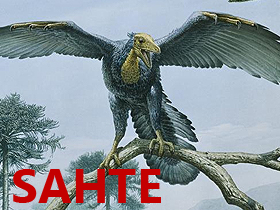This extinct species of bird lived 140 million years ago, during the Jurassic period. The fact that Archaeopteryx had some characteristics that differ from those of modern birds led evolutionists to suppose that it was a transitional species between them and their dinosaur ancestors. According to the theory of evolution, small dinosaurs called Velociraptors or Dromesaurs evolved wings and began to fly; Archaeopteryx is thought to be the ancestor of today’s flying birds.
 The best-known Archaeopteryx fossil, on display in Berlin |
However, the latest research on Archaeopteryx fossils shows that this claim has no scientific basis. This species was not an awkwardly flying transitional species, merely an extinct bird with characteristics different from those of its modern counterparts. Here is the latest research data on Archaeopteryx:
- Originally, the fact that this creature had no sternum was cited as the most important proof that it could not fly. The muscles needed for flight are attached to the sternum located at the base of the rib cage. (Modern flying and flightless birds and bats—mammals which belong to a totally different family—all have a sternum.)
But the seventh Archaeopteryx fossil found in 1992 showed this argument to be false. This particular fossil had a sternum, which evolutionists had long discounted. The following words are from an article in Nature magazine:
The recently discovered seventh specimen of the Archaeopteryx preserves a partial, rectangular sternum, long suspected but never previously documented. This attests to its strong flight muscles, but its capacity for long flights is questionable.37
- There is no difference between the wings of modern birds and those of Archaeopteryx: Both have the same asymmetrical feather structure, which indicates that this creature was an excellent flyer. As the noted paleontologist Carl O. Dunbar pointed out, ‘Because of its feathers, [Archaeopteryx is] distinctly to be classed as a bird.’38
- Another fact that emerges from the feathers of Archaeopteryx is that the creature was warm-blooded. As we know, reptiles and dinosaurs were cold-blooded—that is, their body temperature was determined by the external ambient temperature. One of the most important functions of birds’ feathers is to stabilize keep their body temperature. The fact that Archaeopteryx had wings shows that unlike dinosaurs, it was warm-blooded. That is, it was a true bird that needed a covering of feathers to regulate its body temperature.
But those claws on its wings and its teeth do not indicate that Archaeopteryx had any relation to reptiles. Two species of birds alive today, Tauraco corythaix and Opisthocomus hoazin, have claws that enable them to grip on to branches. Each of these species is wholly a bird, with no relation to reptiles. Therefore, the fact that Archaeopteryx had claws on its wings does not substantiate the claim that it was a transitional form.
 An illustration of Archaeopteryx |
 Research into the anatomy of Archaeopteryx has revealed that the vertebrate had a perfect flying ability and was in fact a typical bird. The efforts to equate Archaeopteryx with reptiles are totally groundless. |
Neither do its teeth. Evolutionists were wrong to claim that these teeth were a reptilian characteristic. In fact, teeth are not a typical characteristic of reptiles. Some living reptiles do not have teeth at all—turtles, for example. More importantly, while no birds with teeth are alive today, when we look at the fossil record, we see that there was a species of bird with teeth that lived at the same time or later than Archaeopteryx. Until very recently in geologic history, there was a group of birds that could be called toothed.
In addition, the tooth structure of Archaeopteryx and other toothed birds is quite different from that of dinosaurs, their supposed ancestors. Noted ornithologists such as L. D. Martin, J. D. Stewart and K. N. Whetstone determined that that the surface of the teeth of Archaeopteryx and other toothed birds were straight and had wide roots. However, the teeth of theropod dinosaurs—the supposed ancestors of birds—had serrated teeth and have straight roots.39
In 1995, Lianhai Hou and Zhonghe Zhou of the Vertebrate Paleontology Institute in China discovered a new fossil that they called Confuciusornis. It is the same age as Archaeopteryx (about 140 million years old) and has no teeth. Its beak and feathers and skeleton are the same as those of modern birds. And, like Archaeopteryx, it had claws on its wings, as well as a feature called a pygostyle that supported its tail feathers.
In short, this creature is the same age as Archaeopteryx, the supposed ancestor of all modern birds. But it was itself very much like modern birds. This contradicts the evolutionist thesis that Archaeopteryx is the primitive ancestor of all birds.40
Another fossil found in China in 1996 caused even more of a stir. L. Hou, L. D. Martin and Alan Feduccia announced in Science magazine the discovery of a 130-million-year-old fossil called Liaoningornis. It had a breastbone to which the flying muscles were attached, as in modern birds. And in other ways too, this creature was no different from modern birds. The only difference was that it had teeth—which indicated, contrary to the evolutionist claims, that teeth in birds did not constitute a primitive characteristic.41
 A reconstruction of Archaeopteryx |
Accordingly, Alan Feduccia wrote in Discovery magazine that Liaoningornis invalidates the claim that birds evolved from dinosaurs.42 Eoalulavis is another fossil that has invalidated evolutionist claims about Archaeopteryx. At 120 million years old, it is 30 million years younger than Archaeopteryx, but its wing structure is the same, and it still seen in some modern species of birds. This proves that 120 million years ago, creatures no different from present-day birds flew through the air.43
One clear proof that Archaeopteryx is not a transitional form between reptiles and birds came from a fossil found in China in the year 2000. Named Longisquama, it was the fossil of a bird that lived in Central Asia 220 million years ago. The well-known magazines Science and Nature, as well as BBC television, reported about this fossil that the entire body of the fossil—estimated to have lived 220 million years ago— was covered in feathers, had a furcula like present-day birds (as well as Archaeopteryx), and that its feathers had hollow shafts.
So it became clear that Archaeopteryx and other archaic birds were not transitional forms. Their fossils did not demonstrate that various bird species evolved from one another. On the contrary, they proved that modern-day birds and some species of birds like Archaeopteryx lived together.
In short, some characteristics of Archaeopteryx show that this creature was no transitional form. And now two noted proponents of the theory of evolution—paleontologists Stephen Jay Gould and Niles Eldredge of Harvard University—have acknowledged that Archaeopteryx was never a transitional form but a so-called “mosaic” creature with several different characteristics.45
37 Kevin Pedian, “Early Bird in Slow Motion,” Nature, 1 August 1996, p. 401.
38 Carl O. Dunbar, Historical Geology, New York: John Wiley and Sons, 1961, p. 310.
39 L.D. Martin, J.D. Stewart, K.N. Whetstone, “The Origin of birds: Structure of the tarsus and teeth,” The Auk, Vol. 97, 1980, p. 86.
40 Pat Shipman, “Birds Do It . . . Did Dinosaurs?.” New Scientist, 1 February 1997, p. 31.
41 “Old Bird,” Discover, Vol. 18, No. 3, 21 March 1997.
42 Ibid.
43 Pat Shipman, “Birds Do It . . . Did Dinosaurs?, New Scientist, p. 31.
44 Terry D. Jones, John A. Ruben, Larry D. Martin, Evgeny N. Kurochkin, Alan Feduccia, Paul F. A. Maderson, Willem J. Hillenius, Nicholas R. Geist, Vladamir Alifanov, “Nonavian Feathers in a Late Triassic Archosaur.” Science, 23 June 2000, pp. 2202-2205; “Earliest feathers fan controversy,” 22 June 2000, BBC News, http://news.bbc.co.uk/2/hi/science/nature/802009.stm.
45 S.J. Gould & N. Eldredge, Paleobiology, Vol. 3, 1977, p. 147.


